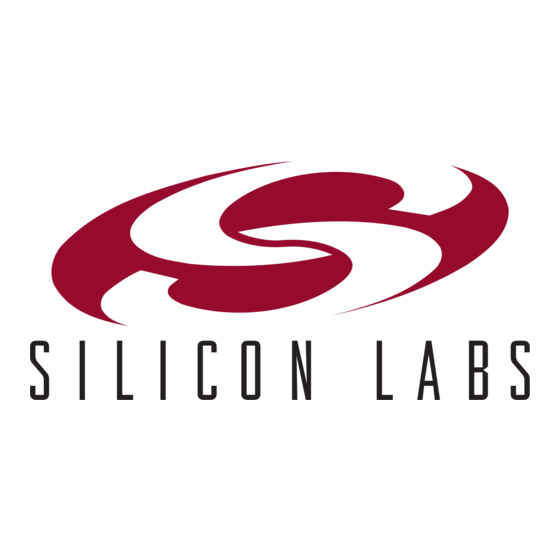
Table of Contents
Advertisement
Quick Links
T
S
C 8 0 5 1 F 3 2 1 D
O O L
TICK
1. Handling Recommendations
To enable development, the ToolStick Base Adapter and daughter cards are distributed without any protective
plastics. To prevent damage to the devices and/or the host PC, please take into consideration the following
recommendations when using the ToolStick:
Never connect or disconnect a daughter card to or from the ToolStick Base Adapter while the Base Adapter is
connected to a PC.
Always connect and disconnect the ToolStick Base Adapter from the PC by holding the edges of the boards.
Avoid directly touching any of the other components.
Manipulate mechanical devices on the daughter cards, such as potentiometers, with care to prevent the Base
Adapter or daughter card from accidentally dislodging from their sockets.
Rev. 0.1 3/08
A U G H T E R
Figure 1. Proper Method of Holding the ToolStick
Figure 2. Improper Method of Holding the ToolStick
Copyright © 2008 by Silicon Laboratories
To o l Sti c k - F 3 2 1 D C
C
U
ARD
'
G
S E R
S
U I D E
C8051F321DC
Advertisement
Table of Contents

Summary of Contents for Silicon Laboratories F321DC
- Page 1 Adapter or daughter card from accidentally dislodging from their sockets. Rev. 0.1 3/08 To o l Sti c k - F 3 2 1 D C A U G H T E R Copyright © 2008 by Silicon Laboratories ’ S E R U I D E...
-
Page 2: Power Led
A ToolStick daughter card requires a ToolStick Base Adapter to communicate with the PC. ToolStick Base Adapters can be purchased at www.silabs.com/toolstick. 3. ToolStick Overview The purpose of the ToolStick is to provide a development and demonstration platform for Silicon Laboratories microcontrollers and to demonstrate the Silicon Laboratories software tools, including the Integrated Development Environment (IDE). -
Page 3: Getting Started
The Silicon Laboratories IDE requirements: Pentium-class host PC running Microsoft Windows 2000 or newer. One available USB port. 5.1.2. 3rd Party Toolsets The Silicon Laboratories IDE has native support for many 8051 compilers. The full list of natively supported tools is: Keil Raisonance Tasking... -
Page 4: Configuration Wizard
4 kB and have the programs start at code address 0x0000. 5.3. Configuration Wizard 2 The Configuration Wizard 2 is a code generation tool for all of the Silicon Laboratories devices. Code is generated through the use of dialog boxes for each of the device's peripherals. - Page 5 ToolStick-F321DC 5.4. Keil uVision2 and uVision3 Silicon Laboratories Drivers As an alternative to the Silicon Laboratories IDE, the uVision debug driver allows the Keil uVision2 and uVision3 IDEs to communicate with Silicon Laboratories on-chip debug logic. In-system Flash memory programming integrated into the driver allows for rapidly updating target code.
-
Page 6: Hardware Setup
To olSt ick-F 32 1DC 6. ToolStick C8051F321 Daughter Card Features Demo The ToolStick kit includes a few simple code examples. The example described in this section is titled F321DC_FeaturesDemo. The purpose of this example is to guide a new user through the features and capabilities of the IDE and demonstrate the microcontroller’s on-chip debug capabilities. - Page 7 This section describes how to open the IDE, open and build a project, connect to a device and download the firmware. 1. Open the Silicon Laboratories IDE from the Start → Programs → Silicon Laboratories menu. 2. In the IDE, go to Project → Open Project.
- Page 8 To olSt ick-F 32 1DC 6.4. Viewing and Modifying Registers All registers on the device can be viewed and modified when the device is in a halted state. The registers are grouped together according to which peripheral or part of hardware they belong. As an example, this guide shows how to open the ADC0 Debug Window and disable the ADC0 directly from the IDE.
- Page 9 Changing the values of variables does not require recompiling the code and redownloading the firmware. At any time, the device can be halted and the values of the variables can be changed. The firmware will continue execution using the new values. ToolStick-F321DC Rev. 0.1...
- Page 10 To olSt ick-F 32 1DC 6.6. Setting and Running to Breakpoints The Silicon Laboratories microcontroller devices support up to four hardware breakpoints. A breakpoint is associated with a specific line of code. When the processor reaches a hardware breakpoint, the code execution stops, and the IDE refreshes all debug and watch windows.
- Page 11 The right column is the disassembled instruction. The Disassembly debug window and the capability to single-step through firmware allows a developer to see exactly what instructions are executed and their output. ToolStick-F321DC Rev. 0.1...
- Page 12 This section describes how to use ToolStick Terminal to communicate with UART from the PC to the daughter card through the ToolStick Base Adapter. 1. If the Silicon Laboratories IDE is open, close the IDE. The IDE and the ToolStick Terminal cannot communicate with the daughter card simultaneously.
- Page 13 Interface" at www.silabs.com for more information regarding pin sharing. 9. Information Locations Example source code is installed by default in the C:\SiLabs\MCU\ToolStick\F321DC\Firmware directory during ToolStick installation. Documentation for the ToolStick kit, including this User's Guide, can be found by default in the C:\SiLabs\MCU\ToolStick\Documentation and C:\SiLabs\MCU\ToolStick\F321DC\Documentation directories.
- Page 14 To olSt ick-F 32 1DC 10. C8051F321 Daughter Card Schematic Rev. 0.1...
- Page 15 ToolStick-F321DC OTES Rev. 0.1...
-
Page 16: Contact Information
Silicon Laboratories products are not designed, intended, or authorized for use in applications intended to support or sustain life, or for any other application in which the failure of the Silicon Laboratories product could create a situation where per- sonal injury or death may occur.

Need help?
Do you have a question about the F321DC and is the answer not in the manual?
Questions and answers